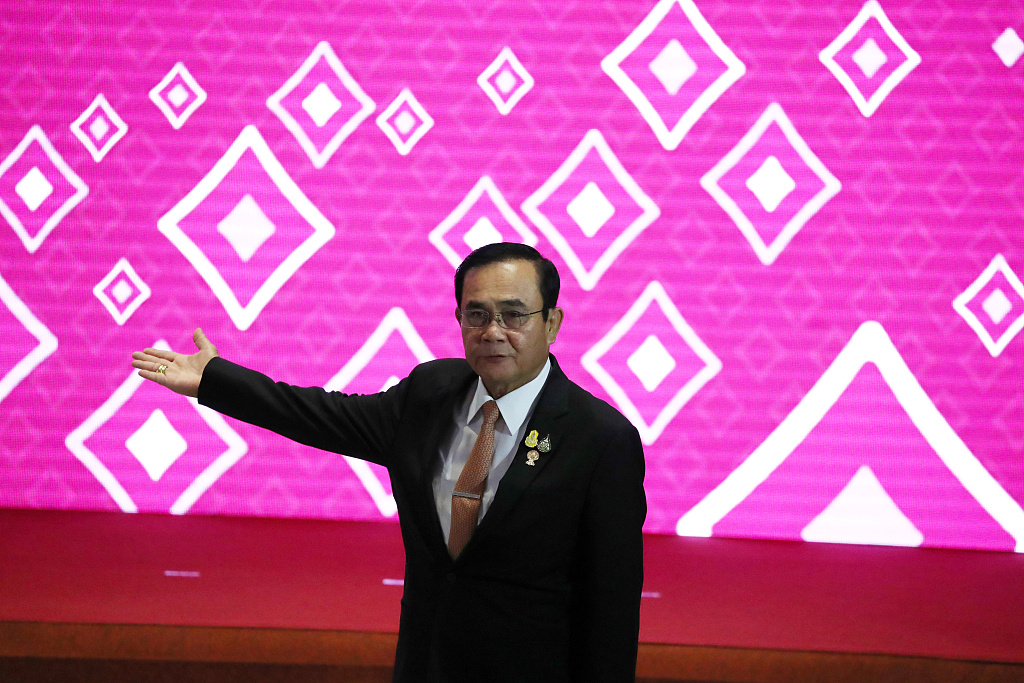
Thai Prime Minister Prayut Chan-ocha delivers opening remarks during the plenary session of the 35th Association of Southeast Asian Nations (ASEAN) summit in Bangkok, Thailand, November 2, 2019. /VCG Photo
Thai Prime Minister Prayut Chan-ocha delivers opening remarks during the plenary session of the 35th Association of Southeast Asian Nations (ASEAN) summit in Bangkok, Thailand, November 2, 2019. /VCG Photo
Editor's note: Zhong Feiteng is a professor at the National Institute of International Strategy, Chinese Academy of Social Sciences. The article reflects the author's opinions, and not necessarily the views of CGTN.
For years, Thailand has been the most popular outbound destination for Chinese tourists. At the beginning of 2013, the film Lost in Thailand, shot by a Chinese artist, was the highest grossing hit of a Chinese domestic film, and it also made Chinese tourists more interested in Thailand.
However, the growth rate of Chinese visitors to Thailand has fallen in recent months. In an attempt to further attract Chinese tourists, Thailand has decided to extend the exemption of visa fees on arrival, which was originally scheduled to expire on October 31, for another six months from November 1, 2019 to April 30, 2020. The policy will save Chinese tourists about 65 U.S. dollars in visa fees.
The Chinese government will welcome Thailand's move. In recent years, outbound Chinese tourism has been seen as an important measure to enhance mutual trust between China and its neighbor countries.
In an article published by Thai media ahead of his visit to Thailand, Premier Li Keqiang said that there are nearly 4,500 flights between China and southeast Asian countries every week, and 57 million visits were made between the two sides in 2018, among which more than 10 million Chinese tourists visited Thailand.
Because of this, Thailand accounted for 6.3 percent of Chinese outbound tourists in 2018, ranking first among China's neighboring countries. It is worth noting that this proportion far exceeds that of China-Thailand trade.
According to China's General Administration of Customs, from January to September 2019, China's trade with Thailand totaled 66.4 billion U.S. dollars, accounting for two percent of China's foreign trade, up one percent year-on-year.
Among them, China's export to Thailand was 32.4 billion U.S. dollars, accounting for 1.8 percent of China's total export, and China's import from Thailand was 34.1 billion U.S. dollars, accounting for 2.2 percent of China's total import.

Tourists visit The Grand Palace, a complex of buildings at the heart of Bangkok, Thailand. /VCG Photo
Tourists visit The Grand Palace, a complex of buildings at the heart of Bangkok, Thailand. /VCG Photo
Among southeast Asian countries, trade between China and Thailand grew slightly faster than that of Indonesia, but significantly behind Singapore, the Philippines, Vietnam and Malaysia.
From January to September 2019, the overall trade between China and ASEAN countries increased by 5.9 percent, among which the bilateral trade between China and Malaysia increased by 11.4 percent. In this respect, Thailand has lagged behind its major ASEAN trading partners. In comparison, however, China's trade with the United States grew at a negative 14.8 percent rate.
At present, the world is concerned about the broad impact of the trade war between China and the United States. In the case of southeast Asia, while most researchers believe that it will benefit in the short term, there is considerable uncertainty in the long term.
According to data provided by the Asian Development Bank, Thailand's goods export growth has been negative for eight months since September 2018. In fact, with the exception of Vietnam, negative export growth is common in the region.
In particular, multinational companies are making dynamic adjustments to their production processes based on the prospect of Sino-U.S. trade frictions. More and more studies believe that the uncertainty of trade policy will continue for many years and the adjustment of industrial chain is unprecedented.
As an important automobile and electronics production base in east Asia, Thailand will be increasingly affected by the uncertainty of trade policies and the adjustment of industrial chain.
In this context, Thailand clearly needs to rethink its foreign economic policy. Thai Prime Minister Prayut Chan-ocha said in an interview with Xinhua News Agency that the cooperation between Thailand and China is satisfactory and Thailand will further participate in the Belt and Road Initiative (BRI) to promote connectivity between southeast Asia and China.

Thai Prime Minister Prayut Chan-ocha attends the 22nd ASEAN Plus Three Summit in Bangkok, Thailand, November 4, 2019. /VCG Photo
Thai Prime Minister Prayut Chan-ocha attends the 22nd ASEAN Plus Three Summit in Bangkok, Thailand, November 4, 2019. /VCG Photo
Prayut also said Thailand hopes China's development strategy of the Guangdong-Hong Kong-Macao Greater Bay Area can connect with Thailand's "Eastern Economic Corridor" to help promote scientific and technological innovation and strengthen cooperation in the field of e-commerce.
For China, advancing regional economic integration is a long-term strategy. In building open regional multilateral economic cooperation, China and ASEAN countries have strong interests and momentum for cooperation.
The two sides have high expectations for the conclusion of negotiations on the Regional Comprehensive Economic Partnership (RCEP) by the end of this year.
Premier Li Keqiang said that in the future, China will be committed to achieving a higher level of connectivity with ASEAN. Here, the Premier Li was referring to a railway project between China and Laos which is set to be completed by the end of 2021, by which China's city of Kunming will be directly connected to Laos' capital city Vientiane.
As China's economy turns to high-quality development and attaches more importance to innovation and digital economy, cooperation between China and ASEAN countries in this regard will be greatly enhanced.
The cooperation between China and Thailand is one of the areas in southeast Asia that has made rapid progress in the BRI, especially after China and Japan reached the Third-Party Market Cooperation, where China and Japan carried out in-depth cooperation in the industrial parks in Thailand. Therefore, Thailand has good conditions to become a demonstration area of this new cooperation model.
Against the background of Sino-U.S. trade frictions, Thailand will be able to undertake more industries transferred from China. Different from Japan's transfer to southeast Asia in the late 1980s, China's industrial transfer has a deeper industrial chain foundation.
The new regional economic cooperation based on product division of labor rather than industrial division of labor will be conducive to the formation of a closer economic network between China and Thailand.
(If you want to contribute and have specific expertise, please contact us at opinions@cgtn.com)